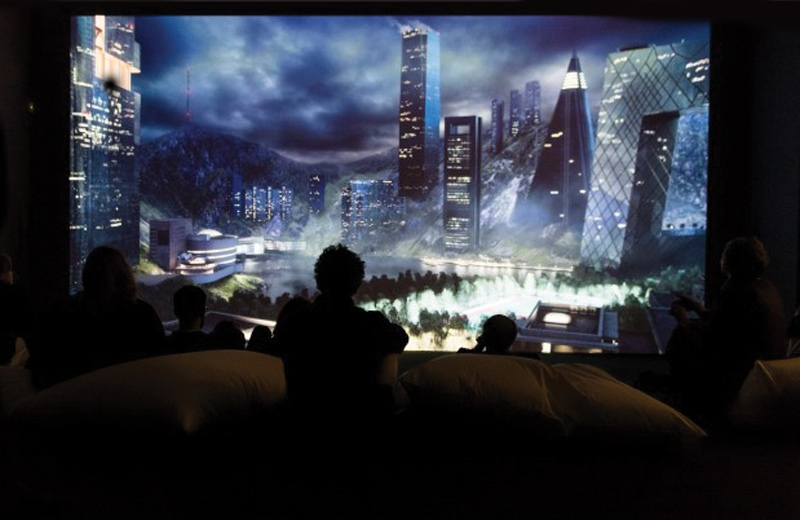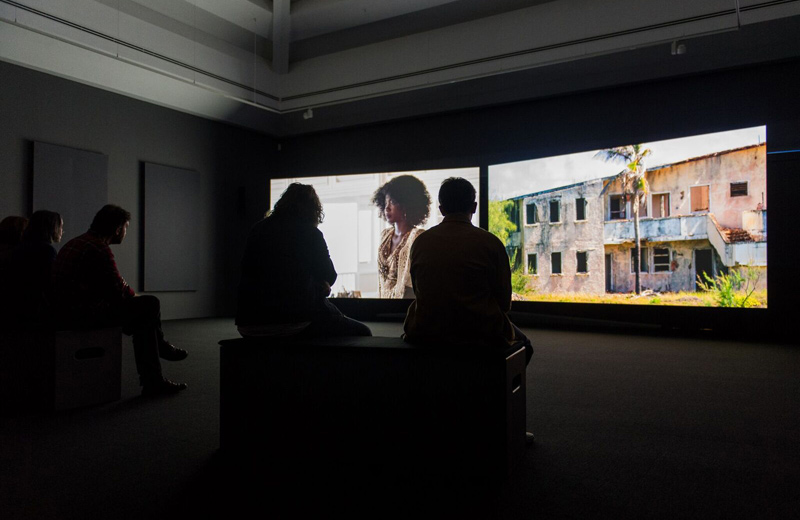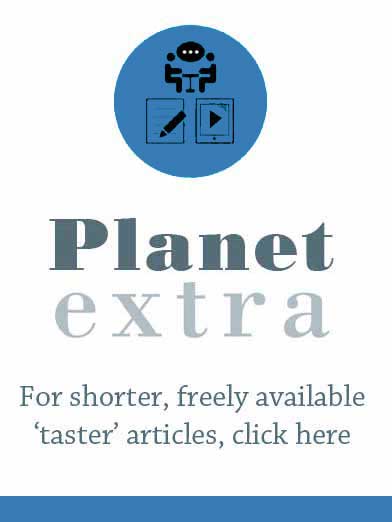‘Artes Mundi 7’: Familiar Landscapes and Distant Trauma 22.02.17

Lloyd Roderick reviews the latest exhibition from Artes Mundi, the Cardiff-based biennial international visual arts show and prize. ‘Artes Mundi 7’ is on until 26 February 2017 at National Museum Cardiff and Chapter Arts Centre.
Tyrrau Mawr/Big Towers (Bedwyr Williams, 2016) shows a location familiar to anyone with an interest in the visual culture of Wales: Cader Idris. The site can be used to trace developments in style and technique in landscape art from Welsh and visiting artists, from Richard Wilson and J.M.W. Turner to Duncan Grant, Augustus John, J.D. Innes, Christopher Williams and serial Cader painter, Kyffin Williams.

Bedwyr Williams, Tyrrau Mawr, 2016. 4K Video Installation 20 minutes video loop. Artes Mundi 7 installation view, National Museum Cardiff, 2016. Courtesy the artist and Limoncello Gallery. Photos Polly Thomas.
Bedwyr Williams shows Cader Idris having sprouted a new mega-city, gleaming skyscrapers surrounding Llyn-y-Cau. The twenty minute video loop projected to 11 metres in high definition shows the change from night to day, the lights of the buildings indicating the new population of the city, the absence of figures in its public spaces emphasising the alienation and loneliness of modern urban life. The video includes a narration by Williams describing scenes from the early history of the city. The city is young (not even as old as some of the fillings in the narrator’s teeth, as he reminds us) but the vignettes evoke the weariness created by hyper-modern, urban life, albeit retaining an unexpectedly warm humour throughout. An example:
‘“I love it when an architect is allowed to play…” Says someone, in a very good fish restaurant.’
Written on the page the statement appears cutting. It addresses not only the inanity of the chattering classes but also the vacuity of contemporary art criticism, which makes reviewing an exhibition of contemporary art very difficult. This isn’t delivered with malice, though. The narration of the work emphasises Williams’s particular strengths as a writer as well as an image-maker, and while the works exhibited should be given careful and thorough consideration, the viewer is given a gentle reminder not to take themselves too seriously.
A common criticism of contemporary art is its alienation from everyday events, and the opacity of its subject matter and language of its discussion. Such a criticism cannot be levelled at ‘Artes Mundi 7’. The themes addressed by the work of six international artists: migration, despotic rulers, urban expansion and gentrification and the processes associated with food production could not have been more of the now.

John Akomfrah, Auto Da Fé, 2016. Two channel HD colour video installation, 5.1 sound 40 minutes 30 seconds. Artes Mundi 7 installation view, National Museum Cardiff, 2016. ©Smoking Dogs Films. Courtesy the artist and Lisson Gallery, London. Photos Polly Thomas.
Another highlight of the exhibition is Auto Da Fé (2016) by John Akomfrah, the artist who won this year’s Artes Mundi prize, which builds on previous work using lens-based media to explore issues around migration, colonialism and diaspora. The two-channel video is an episodic telling of migrations caused by religious persecution, beginning with the flight of Sephardic Jews from Brazil to Barbados in 1654, to present day disasters in Hombori (Mali) and Mosul (Iraq).
Auto Da Fé is not as sensually overwhelming as Akomfrah’s Vertigo Sea (2015), a three-screen film examining man’s relationship with and use of the sea through such activities as slavery, migration and whaling, but is equally affecting. The silence of the characters in each episode is disquieting. It reminds the viewer of our own comforting ignorance about historical flights from persecution and wilful silence around the causes of crises which face us today. Episodes are differentiated by title screens and marked by characters wearing period costume from particular eras, but the disparate settings are filmed at same location, emphasising the commonality of the trauma and loss caused by migration. Transport and movement are also central to Amy Franceschini/Futurefarmers’ installation in which the artists shipped grain excavated in Norway by sea to Cardiff en-route to the Middle East. The various cases and cabinets show the objects associated with grain cultivation and transport that have been part of food production for centuries, and Franceschini/Futurefarmers’ interactions with bakers on their journey by sea, but the epic nature of their work can only be suggested in a gallery setting.
Loss is a key theme of Lamia Joreige’s contributions to the exhibition, both literal (one work lists objects that are missing from the National Museum of Beirut) and metaphorical: Under the River is a three-channel video installation documenting the rapid urban development of districts around a river in Beirut and resulting changes to demography. Interviews with Syrian construction workers who arrived in Lebanon after fleeing the civil war are particularly affecting. Joreige’s work is split between the National Museum and Chapter Arts Centre, which also includes a striking audiovisual installation by Nástio Mosquito. The video aspect of the work shows the artist playing the part of a despotic leader rehearsing a speech, interrupting himself to record notes for speechwriters or other aides. It’s a witty work which takes on a tragi-comic quality in the current political climate.
Neïl Beloufa’s installation (in the National Museum) also addresses power, conflict and social interaction. World Domination (2015) shows participants in a game of global politics. The film is projected onto an uneven resin surface, its crags and protrusions resembling a rock-face. While this makes for a number of striking images of tension from the participants, my inability to read the subtitles or follow the progression of the game made it a frustrating look at the machinations on global politics, although perhaps this was the point.
The installations at Chapter felt sparse: perhaps an unintended outcome of Hiro Steyerl’s withdrawal from ‘Artes Mundi 7’ for personal reasons. Her work around the proliferation of digital images in relation to feminism and militarisation would have worked well with the other selected artists. Curator Karen MacKinnon made a statement following the withdrawal that ‘we are already discussing working with Hito on another project in the not too distant future’. If an exhibition comes to fruition and is of the quality of ‘Artes Mundi 7’ this will be one to look forward to.
If you appreciated this article, you can read longer articles on a wide range of topics in Planet magazine, and you can buy Planet here.
About the author
Lloyd Roderick is Subject Librarian for Art and Art History at Aberystwyth University. His PhD research focused on the digital reproduction of art collections and landscape art in Wales.
If you liked this you may also like:
John Knapp-Fisher
Peter Wakelin celebrates the life and work of the Pembrokeshire-based artist John Knapp-Fisher.
Planet Art Podcast
Peter Lord drops in to the Planet studio to talk about his book, Relationships with Pictures - Lloyd Roderick poses the questions
Our readers respond to half a century of Planet!
This year, as the pandemic necessitated Planet’s 50th birthday party to be postponed until regulations are lifted, we invited our readers to send in their stories and anecdotes about the magazine. We thank everyone who replied for sharing their thoughts, and hope to welcome readers near and far to a celebratory event before too long…
